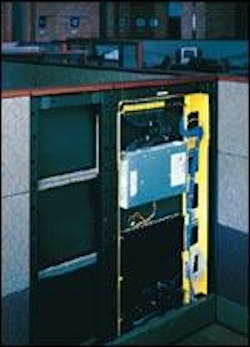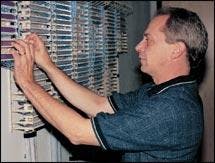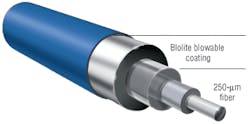Easing network upgrading with air-blown fiber
Combined with a zone cabling approach, air-blown fiber simplifies MACs and network upgrades, with minimal interruption.
Using a zone cabling approach for a network at its new facility in Pittsburgh, PA, Seagate Research chose air-blown optical-fiber to ease installation and for future upgrade capabilities.
The new building for the company that researches storage technology is designed to link workstations for nearly 200 employees. With the project soon to be completed, the Seagate installation features 17.5 miles of optical fiber.
Mike Pesta, information technology manager for Seagate Technology LLC, based in Scotts Valley, CA, says the beauty of the design is that if he wants to reconfigure cubicles or augment the network's design, changes can be made easily.
"If one scientist asked if he could get fiber-to-the-desktop, normally we'd have to run fiber from here to there," says Pesta. "But now I can blow in fiber without disturbing anybody, run a fiber patch cable to his cube, and I'm done."
Zone cabling is a horizontal solution that addresses the changing configurations of an open office. It is designed to minimize cabling complexity and reduce disruption. In a zone cabling approach, installers pre-wire an open-office area by anticipating user volume. The building's floor plan is divided into "zones," which are outlined on the basis of number of users. A bundle of communications cable is pulled from the telecommunications closet to a single, fixed distribution point within each zone. Individual cable runs are then connected from that distribution point to each office outlet.
The zone cabling pilot project took place at Seagate's interim facility at a building at River Park Commons in Pittsburgh. Company employees stayed at this facility while the new building was being completed at One Waterfront Place.
Pesta says a zone cabling approach was the only design he considered for both buildings. One reason was that Seagate intended to make ample use of cubicles rather than conventional offices in both buildings. He liked the concept of being able to send the network backbone out further than the satellite closets. A zone cabling approach let installers bring the fiber closer to the users, and leverage the port counts.
"Without this, I'd be confined to a two-voice and two-data cable design," says Pesta. "That would have been a standard telecom outlet. But what would have happened if I needed a third data port? A zone approach would let me be very flexible in this regard."
Seagate selected Herman Miller (www.hermanmiller.com) Ethospace cubicles that let installers pull cable through a side panel, which is designed for easy access. The zone cabling approach is designed to bring connectivity equipment, such as switches, routers and patch panels, closer to the workstation. The backbone cable is extended out to the workstation. The Ethospace frame is designed to make this and any reconfiguration easier. If the system is to be upgraded, installers remove the frame's Ethocom tiles and install new equipment or fiber.
"We have tiles that fit over the face of the frame, and they come off so you have complete access," says Alex Berman, senior technology product manager for Herman Miller.
The new facility
Pesta says the company was satisfied with the Herman Miller furniture in a pilot project it conducted, and decided to use it again in the new facility. But the plan would be upgraded. "We worked on this in October 2000 and when it came time to install the new building, we tweaked it," says Pesta.
The plan for the new building places active components like Ethernet switches, fiber channel switches or other connectivity devices in each zone frame. The design calls for 30 different cubicle clusters, with each cluster containing no more than eight cubicles. A 25-pair Category 5e cable was pulled to each cluster and terminated on a 24-port patch panel for voice connectivity.
"I've configured two Category 5e data jacks at the end of the patch panel," says Pesta. "If I ever need a reason to get capacity over copper in the cube clusters, I'll have two Category 5e connections run to each cluster."
The furniture included an American Access (www.aatk.com) distribution frame fastened inside each cubicle cluster. Each frame includes a power strip, an Ethernet switch, a fiber patch panel, and patch panel for voice. These were installed in the 30 cubicle zones.
"I liked the idea of not having to run cabling from every closet to every location," says Pesta. "I like to have consolidated points throughout the building that you can reconfigure. It saves time and money on reconfiguring later on."
Bob Dagostino, president of Dagostino Electronic Services, Inc., the Pittsburgh-based contractor that completed the installation, says the zone cabling approach provided Seagate with several advantages, including the ability to upgrade quickly.
"In the future, if you need singlemode fiber to a station, or if a scientist wants to connect singlemode dark fiber to another university, they can call us to say that they need singlemode to this cubicle with a direct connection," says Dagostino.
Air-blown fiber
Originally, Seagate expected to use standard, 50-µm optical-fiber cabling for the new facility. According to the network design, the fiber would be pulled out from the satellite closets to the cubicle assemblies. Installers would install both multimode and singlemode fiber, running to IDFs on each floor of the building.
The plan also called for redundant fiber cables coming from the main communications room to each satellite closet. Cables would be pulled horizontally from there to the workstations. But the installation team believed this would represent overkill with rerouting. Dagostino says his team was asked what sort of value they could add to the proposal, and the challenge was to come up with a solution that was cost-effective and yet still capable of being expanded upon in the future. The team recommended an air-blown fiber solution, which would bring a quicker, more efficient approach.
"The president called and said he'd heard of a blowable fiber product," says Pesta. "I had heard of it, but had never worked with it." Pesta says he was quickly won over by the idea. Part of the allure of the air-blown solution is its easy installation. New fiber can be easily "blown" in, with minimal disruption to employees and their work areas.
"Whatever you need to do can be done without disturbing the end users," says Pesta. "That is the flexibility, where you can augment any fiber lines, upgrade the device in the zone frame, and upgrade the patch cables or change them."
Dagostino says the team decided that the air-blown fiber approach would be more effective because it would eliminate the need for crossconnects and terminations of all fiber in the closet. Air-blown fiber allowed greater flexibility, enabling a single cable run to go from the main communications room to all end points, with minimal decibel (db) loss. Pesta notes that while standard fiber cannot have more than three 90° bends in it, air-blown fiber can accommodate 300 bends.
"This saved money, increased my bandwidth, and doesn't give us losses due to patch cables," says Pesta. "I didn't give up anything for it."
"That would have been just another point of administration and additional labor to do all those terminations in the closets. Now, they go away," says Dagostino.
Making a choice
Dagostino recommended General Cable's (www.generalcable.com) Blolite microducts system for the cubicle clusters, which would extend fiber all the way to the main equipment room. The Blolite solution is designed to be easy to install, and less disruptive to an office environment. It also offers a lower risk of installation damage because it does not place any stress on the optical fiber.
The Blolite solution, Dagostino says, is also adaptable to moves, adds and changes (MACs). One of the advantages is that if the installed fiber develops any problems, it can be easily replaced without having to remove ceiling tiles or make other disruptions.
While the technology is still relatively new, Billie Jo Mitchell, products specialist for General Cable, says blown fiber is catching on because of its low cost and ease when it comes to MACs. "Different types are taking it on now," says Mitchell. "We see it in utility plants, universities, campus environments."
Contractors began the installation with the microduct-a series of tubes that are five or eight millimeters in diameter, run from the main equipment room out to the cluster of cubicles. Contractors installed the Blolite tubes into the system, and then performed a pressure test by using compressed air to send a pellet through to make sure the tubes did not contain kinks or bends. Installers then used compressed air to launch the fiber through the tubing system. No splices were necessary during this installation.
Patch cables were run directly to the cubicles. The final network did not require jacks, faceplates, or the costly labor to conduct terminations other than those at the ends of the fiber.
"When you step back and look at this, we have eliminated all horizontal cable," says Dagostino. "The only copper we have used between the user's workstation and the network is the workstation patch cord that plugs into the back of his computer. Everything else is fiber."
And the cost? "Our approach saved money," says Dagostino. "We are 10 times less the cost of per-megabit delivered."
The final network was designed to provide Seagate with more gigabit capability than it needs-but not too much more. Dagostino says it would be tempting, but costly, to put in too much dark fiber.
"Anybody building out copper and fiber doesn't know what the future is, so that's why they overbuild," Dagostino says. "It's why customers typically overbuild their workstation faceplate requirements to a magnitude of about double."
Nevertheless, the final network was designed to be easily upgradeable using the air-blown technique. Pesta says the network will let Seagate respond to and adopt new technology, which could include running fiber-to-the-desktop, or even introducing 10-Gigabit Ethernet to the workstations.
"A network switch is installed in the furniture panel, and a pneumatic tube is put in to blow fiber to the different locations. A second tube in there is empty for future use," says Tom Swihart, a Holland, MI-based technology consultant and RCCD who acted as a project consultant. "That is the key to this innovative approach-that if they outgrow the bandwidth or capability of the existing fiber, they can take the second tube and blow fiber in without making big changes."
To upgrade the system, installers would simply come in, blow out the old fiber and blow in new to replace it. Or, they could blow in fiber into the empty tubing. The final installation would be cheap, fast, and not disruptive.
"In 15 minutes, we could blow in the amount of fiber they would need to their workstation," says Dagostino. "We could bring in a piece of equipment that looks like a suitcase, set it up, and blow fiber to the users' workstations."
Dagostino continues, "If they need another Category 5 cable, instead of going in there with two installers and running back to the closet, we send in one guy with a patch cord, and he routes it through the furniture. When the user gets back from lunch, the job is done and nobody has been interrupted during the installation."
null




